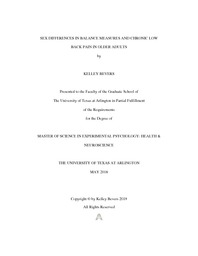
ATTENTION: The works hosted here are being migrated to a new repository that will consolidate resources, improve discoverability, and better show UTA's research impact on the global community. We will update authors as the migration progresses. Please see MavMatrix for more information.
Show simple item record
| dc.contributor.advisor | Gatchel, Robert J. | |
| dc.contributor.advisor | Peng, Yuan Bo | |
| dc.creator | Bevers, Kelley | |
| dc.date.accessioned | 2018-11-12T16:38:44Z | |
| dc.date.available | 2018-11-12T16:38:44Z | |
| dc.date.created | 2018-08 | |
| dc.date.issued | 2018-06-21 | |
| dc.date.submitted | August 2018 | |
| dc.identifier.uri | http://hdl.handle.net/10106/27587 | |
| dc.description.abstract | The older adult population is growing at a rapid pace, with the US Census Bureau estimating older adults to comprise of 20% of the overall population by 2020. Now, more than ever, we must parse out differences within this group to target their specific needs, particularly those concerning potential injury and pain. Older adults face unique challenges surrounding their ability to manage pain conditions, such as increased fall risk, increased medication use, decreased physical ability, and multimorbidities. As such, uncovering the most effective and cost-effective strategies for mobility and maintenance are of vital importance. Previous research indicates there are sex differences in such pain measures, which could provide valuable insight into pain management modalities and rehabilitation measures following injury or illness. The relationships of sex differences in balance measures, such as equilibrium, strategy, and overall balance, are not fully understood, particularly in older adult populations. Relationships between balance and pain, specifically chronic low back pain (CLBP), are also poorly understood. The current study examined older adults (N = 144) with and without chronic low back pain by means of the NeuroCom Balance Master, Senior Fit Test, PROMIS-29 Assessment. Each measure contributed unique biopsychosocial information such as facets of balance, aspects of pain, depression scores, sex, and physical ability. The current study aimed to: examine the relationship of sex and balance; examine the relationship of sex and pain; assess sex and balance as predictors of CLBP; and to look for moderating relationships of sex, balance, and pain. Results indicated there were not sex differences in pain aspects; there were significant effects of sex on balance measures; and the interaction between sex and balance significantly predicted CLBP likelihood. | |
| dc.format.mimetype | application/pdf | |
| dc.language.iso | en_US | |
| dc.subject | Chronic low back pain | |
| dc.subject | Pain | |
| dc.subject | Balance | |
| dc.subject | Sex differences | |
| dc.subject | Older adults | |
| dc.subject | Biopsychosocial | |
| dc.title | Sex Differences in Balance Measures and Chronic Low Back Pain in Older Adults | |
| dc.type | Thesis | |
| dc.degree.department | Psychology | |
| dc.degree.name | Master of Science in Psychology | |
| dc.date.updated | 2018-11-12T16:38:45Z | |
| thesis.degree.department | Psychology | |
| thesis.degree.grantor | The University of Texas at Arlington | |
| thesis.degree.level | Masters | |
| thesis.degree.name | Master of Science in Psychology | |
| dc.type.material | text | |
| dc.creator.orcid | 0000-0003-4303-748X | |
Files in this item
- Name:
- BEVERS-THESIS-2018.pdf
- Size:
- 1.602Mb
- Format:
- PDF
This item appears in the following Collection(s)
Show simple item record


